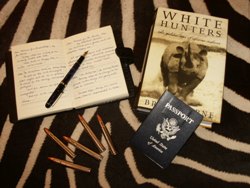

 The Accurate Reloading Forums
The Accurate Reloading Forums  THE ACCURATE RELOADING.COM FORUMS
THE ACCURATE RELOADING.COM FORUMS  Hunting
Hunting  Hunting Reports - Africa
Hunting Reports - Africa  Kei River Hunting Safaris. My hunt June, 07
Kei River Hunting Safaris. My hunt June, 07Go  | New  | Find  | Notify  | Tools  | Reply  |  |
One of Us |
It doesn’t seem like a year since I was sitting down to write up my 2006 Plains Game Hunt, in the Eastern Cape area of RSA, but it is. How time flies. There hardly seems enough time to get all the hunting that I would wish to get done, done, and I do hate having to pass up on any hunting opportunity. Now it is time to write up the 2007 Hunt. For those of you who took the time to read Out of Africa Chapters 1 and 2, (2006 Hunt), posted on a number of the forums I enjoy being part of, you might remember that I took a dose of bronchitis on the hunt with me, which kind of soured the whole trip. I only got to shoot a warthog, blue wildebeest and a bush buck and had to get my two hunting buddies to shoot the kudu, gemsbok and a further warthog for me. Being the selfless guys they are, they made no complaint and just got on with the extra work! However, I digress. In 2006, we decided that we would hunt with Andrew Renton, owner of Kei River Hunting Safaris, who is based near to the town of Komga; about forty-five minutes drive to the North West of East London, in the Eastern Cape of South Africa. Andrew had promised us the hunt of a lifetime and true to his word, we had it. Even through a pretty severe illness, I managed to enjoy a lot of the time and I could not have had better nursing in the East London Hospital. But that is just the kind of folks the Rentons are. Kindness and hospitality is their game. It was no surprise therefore, that when Iain, Paul and I started to discuss our 2007 hunt (over several months, several pints of Guinness and one or two bottles of Iain’s finest Macallan 18 Year Old Malt Whisky), Kei River was top of our list. However, ever being the canny Scot, having defined the hunt packages that each of us required, I contacted every safari operator that either attends our local Game Fairs or advertises in our shooting press and requested a price and details of their hunting outfitter set up. Now I have to say, many offered excellent facilities and I am sure that their hunting would also have been good but we are on a budget and when Kei River appeared in the best three offers, the vote was unanimous. Kei River it was. Kei River Hunting Safaris takes a booth each year at one of our biggest Game Fairs, held at the Weston Park Estate, near to where Paul and I live, so we took the opportunity to visit with Andrew and advise him that we would like to return and hunt with him in 2007. Iain even travelled down from Aberdeen to be with us, so there resulted a bit of a social gathering at the show. Andrew was, of course, too busy extolling the virtues of Kei River, (after all, that is what he had paid good money to do), to take time off to come and enjoy a glass of cider with us. However, Andrew’s wife Sharyn selflessly donned the mantel of Kei River P.R. Director and did, so we drank to our 2007 hunt, scheduled for early June. (Several times, as I recall!!) Because I had not been able to hunt my full package the previous year, I had a bit of catch up to do, so I opted to hunt a trophy package consisting of a kudu, nyala, gemsbok (oryx), common reedbuck, impala, bush buck and the obligatory warthog. (There are three types of package available to hunt. The most inexpensive is the Management Package. This will consist of young males and female animals. Next is the Representative Package, these animals will be around 75% of the way towards being an SCI minimum trophy score and is a bit more expensive. The third is the Trophy Package, where all animals shot will be guaranteed to make the minimum SCI trophy score and again, is a bit more expensive.) I had also expressed a wish to shoot a baboon and Andrew kindly said that if we came across one, I was welcome to take the opportunity gratis. (As it happened I did get an opportunity but I will give the detail of that later on in the story.) Paul had decided to bring his wife Max and thirteen year old son Tom along. Max has sometimes busted clays with us but has never to date, shot a rifle with us but young Tom is passionate about his shooting and never misses an opportunity to be out with his Dad, whether shooting or just doing chores around the pheasant shoot that we are involved with. Since Kei River welcomes wives, families, girlfriends, etc., we had no doubt that Max and Tom would thoroughly enjoy the trip to the beautiful country that is RSA in general and to Kei River in particular. For his hunt package, Paul had chosen an eland, gemsbok, impala, warthog, common reedbuck, bush buck and if the opportunity presented itself, a baboon. (Paul had shot a good baboon the previous year, here is a picture) Paul’s baboon. Paul was proud of this one. The first shot hit but didn’t bring it down. His second did. On the move at almost two hundred yards. 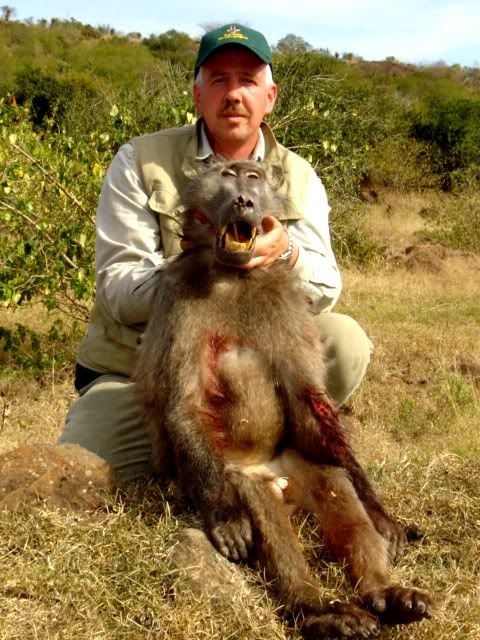 Iain had a wish to hunt a caracal (lynx), so that was number one on his list, followed by a common reedbuck, gemsbok, eland and being a keen bird hunter, some wing shooting. Having taken care of the hunt package and dates, the next Item was to book some flights and because we were ready to make the airline booking in October, 2006, we managed to get flights from U.K. to Cape Town return for £420 (about $840 at current exchange rate). In previous years when we have hunted in the Eastern Cape, we always flew into Johannesburg and then caught a domestic flight to East London the next morning. This means a short overnight stop in Johannesburg and a very early flight out to East London the following morning. By way of a change and to enable us to see another South African city and different parts of the country, we elected to fly to Cape Town, hire a car and drive along the South coast (known as the Garden Route), stopping of at Plettenberg Bay on one night and Kenton on Sea on the second night, making the short drive from Kenton to East London on the third day, to meet up with the Kei River guys. We also booked a flight from East London back to Cape Town, for after the hunt, so we could take a couple of days in Cape Town, before returning to U.K. That done, we just had to sit back and wait for June 2007 and to make our own little bits of preparation. Both Paul and I (having developed a bit of an interest in shooting at longer ranges) decided that we would buy a new scope, better suited to longer ranges. We settled on the Swarovski PV-S 6 – 24 x 50 with a TDS4 Reticle and Parallax Adjustment. So, pooling our buying power, we went off to a local gun shop and placed the order. This scope has the reticle in the second focal plane so the reticle dot does not get bigger as the magnification is increased. It also has a number of stadia bars so one can work out from the ballistics of the round being used, the distances that each stadia bar corresponds to. This system works well but still requires a little bit of “Kentucky Windage†to be applied. We had great fun setting the scopes up and were able to shoot litre bottles of water off a fence at 450 yards using the requisite stadia bar. Since we were unlikely to take any shots further than that, (if that), we were quite convinced that nothing would get away. Subsequent to all the fun as described in the last paragraph, Paul had a change of heart, (influenced by a friend of ours who is one of the U.K.’s top bench rest shooters), and bought a Night Force scope and added Kenton Industries turrets, custom made for his scope and chosen round which is 7mm Remington Magnum, with a 140gn Nosler Partition Bullet. This system worked so well for him that on my return, I took a second mortgage on the house (please do not tell my wife) and bought one myself. However, at time of writing, I have not had the opportunity to collect the ballistic data I need to order the Kenton Industries turrets. That can be my next project. Shooting magazines and gun shop advertisements were scrutinised, of course, to make sure that we had every little bit of kit that we might just need for our hunt and which we would regret taking, when we would be hit for excess baggage by the airline on the way back. (It didn’t happen this year.) I limited my purchases to a new pair of boots (well broken in before I left for the hunt) and a pair of Hush Puppies, which in U.K. are comfortable shoes and not these delightful tasting little rissole type things you get served up with catfish in the U.S.!! Just before leaving though, my wife (bless her) presented me with a Leica CRF 1200 Rangefinder. This is a lovely and efficient bit of kit, which can be tucked away comfortably in the breast pocket of one’s shirt. I was glad to have it with me. In fact, the days seemed to whiz by and before we knew it, it was time to load up the ammunition we would need for our hunt and for a last minute sighting in and practise session. I used a Winchester Model 70 Ultimate Shadow in .300WSM with the Swarovski scope as described previously. The rifle is fitted with a BR Reflex T8 sound moderator. This not only drops the decibels to that of a .22 Magnum Rimfire, but takes out most of the recoil, to a level of about the .243 Winchester and makes it much easier to shoot accurately. Paul used his Remington Sendero in 7mm Magnum and Iain, who usually favours his Dumoulin .30-06, decided this year to borrow Andrew Renton’s .375 H&H Magnum, just to see what it was like. The Eastern Cape area of RSA is malaria free and lots of inoculations are not required. It is wise to get shots for Hepatitis A, Tetanus, Polio and Typhus. Just in case. It is really up to the individual but I take every shot that is going. I did in the military, carried on though my life travelling in the oil and gas industry and still keep them up to date. I have not come across any real nasties there and even the snakes are sleeping at the time of year we went. The worst thing we came across were ticks and then only in certain types of terrain. I travelled out with Paul and his family (I live only 400 yards from him) and he picked me up at around 0300hrs to make the one hour drive to Manchester and caught the early flight to Schipol Airport, Amsterdam, where we picked up the flight to Cape Town. Iain had travelled out a week previously, to look up an old friend before they left RSA to live in Australia. We would meet up with Iain in Plettenberg Bay, the evening after we arrived. The flight lasted for eleven hours and we were pretty glad to get off the plane. The Immigration process in RSA is painless and having retrieved our baggage from the carrousel, we made our way to the security office to pick up our rifles. We and the rifles, led by a security man, were taken to the police office in the arrivals hall. We presented our paperwork to the officer on duty and within thirty minutes, were issued with our temporary RSA firearm pass. No problems there. Paperwork right equals easy and stress free. When I opened my gun case to let the police officer check the serial number, I noticed that the baggage handlers had managed to break one of the polypropylene catches on my Pelican gun case. Now, Pelican say that their cases are unbreakable and though the airline was responsible for paying for the repair, Pelican refused to take payment. They just sent me a new catch and pin saying that when they say unbreakable, they mean it or they pay. It is good to see another company that stands by its warranty as Swarovski do. Two hours later, we had checked in to the airport hotel (very reasonably priced for an airport hotel), placed ourselves outside of a six pack of Castle Beer (Max only had one can and Tom a Coke) and so to bed. I had reserved a rental “people carrier†to be picked up at 1000hrs and after a mediocre breakfast, Paul and I went to pick it up and having done so, went back to the hotel for Max, Tom and the luggage and headed East on the N2 Motorway, leaving Cape Town and heading for Plettenberg Bay, where we would stop for a night and where Iain was waiting to meet us. He had arrived the day previous, in order to carry out a recce and ascertain the location of the best pub and restaurant. Roads were much quieter than the U.K. roads so the journey was very pleasant and the scenery interesting. We arrived at Plettenberg Bay at around 1600hrs and found our accommodation, Bitou Lodge, a really first class chalet type bed and breakfast, located on the banks of a river. Bitou Lodge is situated in a nature conservation area and if you have an interest in bird watching, it is the place for you. There were canoes that residents could take and explore up and down the river and the proprietor advised us that using the canoes would be the best way to see the birdlife. However, we did not have enough time to avail ourselves of that particular facility. Iain was already there and had thoughtfully filled up his fridge with a variety of beers and soft drinks, so over some Castle and Windhoek lager, we tried to make the decision as to which of Plettenberg Bay’s excellent restaurants we would go to for dinner. Being unable to achieve consensus before Iain’s fridge was empty, we repaired to a very nice pub, situated on the cliff top overlooking the bay. Our waitress told us that sometimes one could see whales cavorting in the bay, as one enjoyed one’s beer. Alas, the whales were cavorting somewhere else that evening. Decision made, we took off to a seafood and steak restaurant, where I overdosed on oysters (expensive and hard to get in U.K.) and we all enjoyed a selection of kudu, ostrich, steak and local fish, not to mention some excellent South African wine. Next day, after a fantastic selection of breakfast foods, we were on the road to our second destination, Kenton on Sea, a little town just along to coast to the South of East London. We stopped off to look down into the gorge formed by the Storms River, from the Paul Sauer Bridge, very impressive, and deep! On route and at Iain’s suggestion, we took a small detour and visited Addo Elephant Park. We spent some three hours, just driving around and looking at the animals. We only saw eighteen elephants but we did see lots of kudu. In fact, there were hundreds of them!! Warthogs, springboks, buffalo, zebra, blesbok, giraffe and impala were everywhere. Regrettably, the rifles had to stay locked in their cases. This warthog had no fear.  Neither did this buffalo (I did though!!) 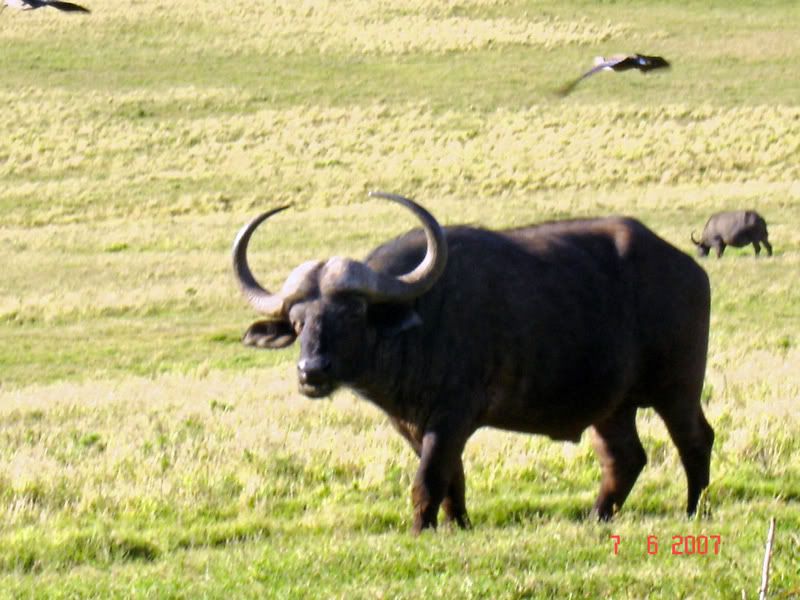 A disinterested zebra. 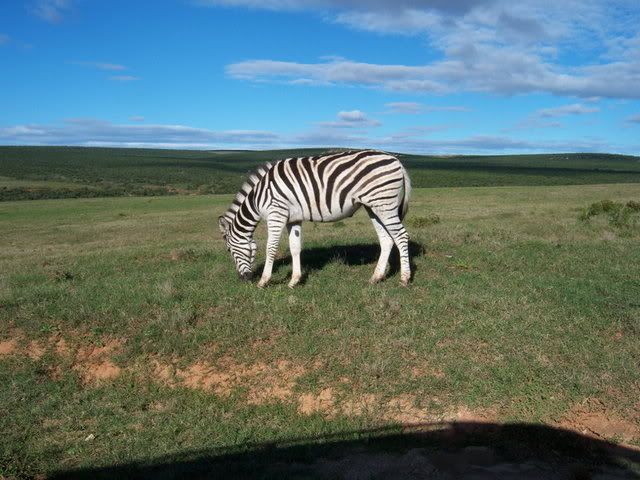 Addo was an interesting place to visit and I would recommend it to anyone planning a safari in the Eastern Cape to set a day aside to visit there. Good eating is not difficult to find in RSA and even in a very small, seasonal and tourist town like Kenton, there was a first class restaurant where again we enjoyed a fine dinner. Regrettably, our accommodation for that night was nowhere near the standard of the previous night, but it was tolerable and since we knew that the next night we would be at Kei River’s Rentons Lodge, it did not seem to matter that much. Twelve noon on the next day, we were at East London Airport, handing back the rental vehicles. (My vehicle was handed back, full of fuel, no bashes or dings and nothing due to pay since it was prepaid in U.K. However, when my Visa statement came in last week, Europcar had hit it for £57!! No explanation, justification or anything! Beware of Europcar. Sharyn Renton was there to meet us along with Professional Hunter, Allan Schenk. Andrew Renton had sent his apologies for his not being able to meet us personally, as he was out hunting with two gentlemen from North Carolina. Once all of our gear was loaded on to Allan’s truck or into Sharyn’s Toyota Landcruiser and we were ready to take off for Komga and Rentons Lodge. There is an adage that whenever one goes away from home, business or vacation, one will always forget something. Well, Paul is no exception to this rule and he had indeed, forgotten his rifle sling. Accordingly, a side visit to East London’s gun store was necessary. This is a family business and we had met one of the sons before, as he is one of the Professional Hunters (PH) that assists Andrew Renton at Kei River Hunting Safaris. Visits to gun stores are never onerous and this was no exception. I think that we all bought something. Sharyn and Allan then took us for lunch at East London’s best (in my opinion) sea food restaurant and having satisfied the inner man and woman, we left for Komga. The journey from east London to Rentons Lodge takes about an hour, so after my usual trick of falling asleep before we left East London, it didn’t seem long to me before we were pulling up at the Lodge door. It had been a year since our last visit but when we walked through the door of the Lodge, it seemed like we had never left. It is a difficult feeling to put into words but the atmosphere of the Lodge, the setting, the smells and the real feeling that you are welcome, I guess had never left me, when, after the previous visit, I left them. Memories of hunting past and hunting still to come seemed to fill every corner of the Lodge. You can read about “the magic of Africa†in just about any story about Africa but in this case and for me at least, that magic felt very powerful indeed and the urge to visit again gets more impelling with each visit I make. The Rentons’ Lodge. 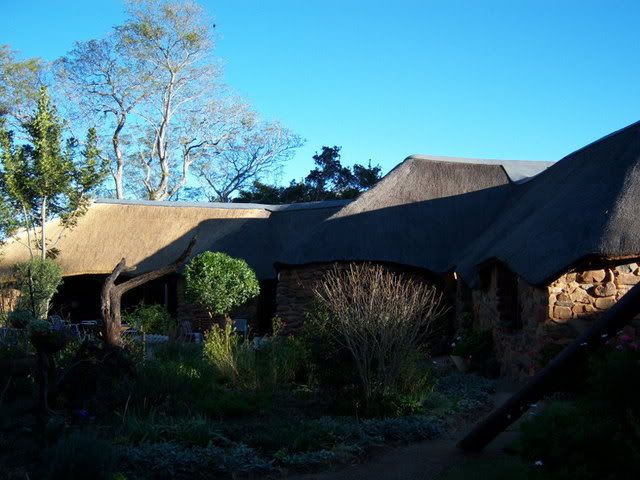  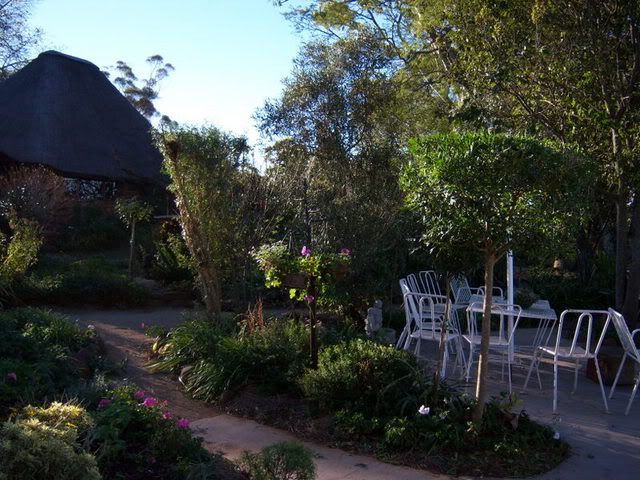 Since there was still plenty of daylight left, Allan suggested that we take a trip to the firing range, to check that our rifles still held their zero, after their time under the tender care of the airline baggage handlers. On the way to the range, we met Andrew Renton, returning from a successful hunt with the two hunters from the U.S. They had been out looking for a baboon and had managed to get one. Introductions and pleasantries over and having given each other assurances that we would meet up in the bar later, we continued to the range, while the two U.S. hunters, Mike and Don, headed back to the Lodge for a shower. They were at the end of their hunt and were looking perhaps just a little fatigued. Iain took the opportunity our chance meeting provided, to pick up Andrew’s .375 H&H Magnum, which Iain was to use during his hunt and which Andrew had been using that day. Having arrived at the range and having set up a target at a hundred yards, we checked our rifles to find, amazingly, they were still shooting straight. None of us had ever shot a .357 H&H Magnum before and found it an interesting experience and not as daunting as we may have thought. “Sighting in†over, we repaired to our respective accommodation for a shower and change before meeting up at the bar. 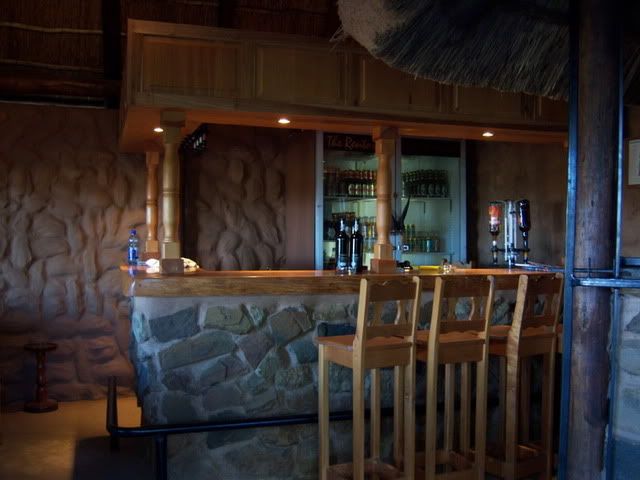 As usual, I was there first, to be welcomed by Andrew’s father Gordon, who ensured that I had a cold beer in my hand by the time the others started to come in. As the conversation turned, as is almost obligatory, to hunting, we were joined by Mike and Don. In conversation, we found out that Mike and Don were from North Carolina. To say that they were keen hunters is really unnecessary, as anybody who travels to Africa to hunt must be so. I was very interested to meet North Carolina residents as it is a State that, along with South Carolina, I would love to visit and which is certainly on my “Places to Visit Listâ€. As I understand, after the Scottish 1745 Rebellion ended in the disastrous (for the Scots at least) Battle of Culloden, in 1746, where Prince Charles Edward Stuart (The Bonny Prince) and his army of Scottish Highlanders were defeated soundly by the English army, a great many Scots left Scotland to settle in the Carolinas and West Indies. I also understand that there is an area (in which of the Carolinas I am unsure) in one of the Carolinas where folks speak Gaelic, and English with a Scots accent, have Scottish Highland Games, Scottish Highland dancing and enjoy Scottish bagpipe music!! Maybe some kind reader can give me more information, for alas, my two new friends could not. However, again I digress. Mike and Don joined in with our company and we with theirs as naturally as could be and in the way I have sometimes experienced with fellow hunters, even where language barriers occur (Which did not in this case.). The evening that followed was one of the best evenings of hunting and human camaraderie I have ever experienced and it was sad we were, when Mike and Don left camp the next day, to return home to the U.S. Mike and Don may meet up with us next year, as they intend to return. As a result of this chance meeting, I have an invitation to visit in North Carolina and hope to do so later this year (one more tick on the list) and God willing, will take Mike hunting in Scotland, in September this year. Mike, Don and Iain share a joke 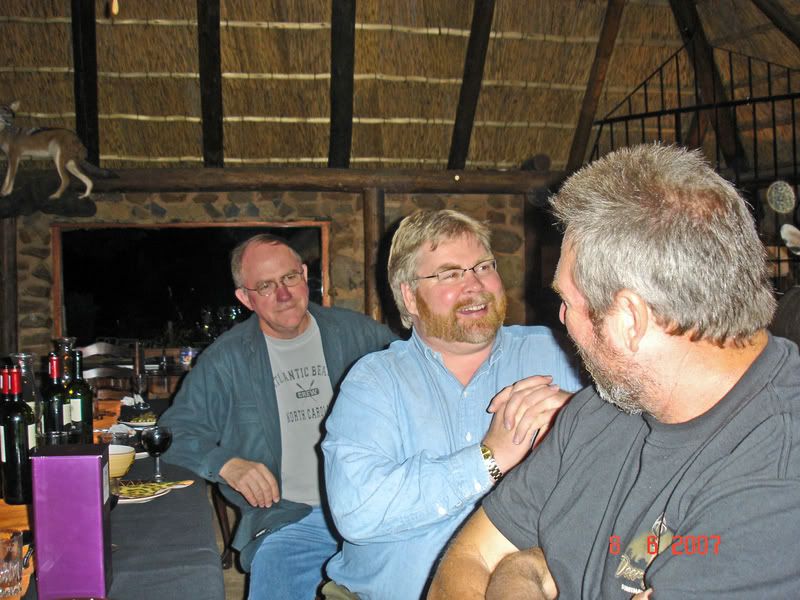 Mike and Don had had a most successful hunt and have kindly agreed that I may show some of their hunting pictures. Here is Mike with a very fine Lion. 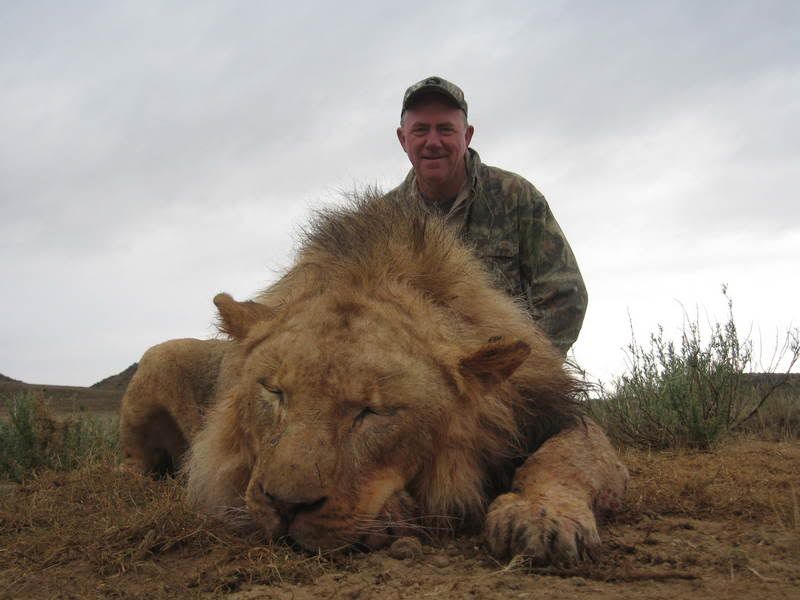 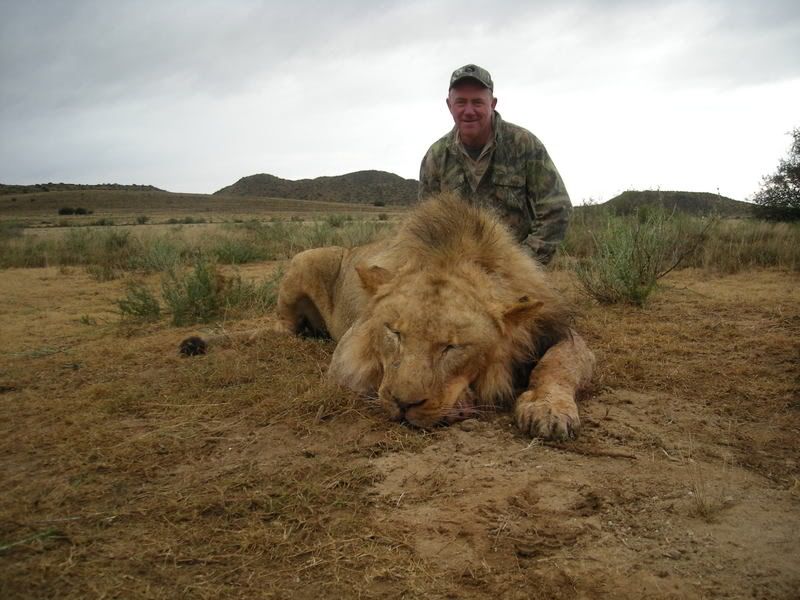 Together with Don and his Lioness, joined by their PH Benton  And a Nyala 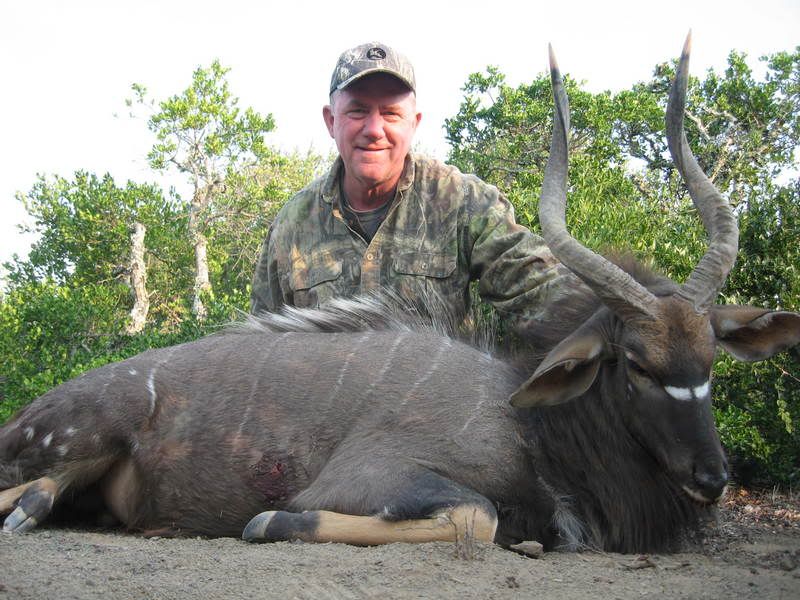 Don got a Red Hartebeest 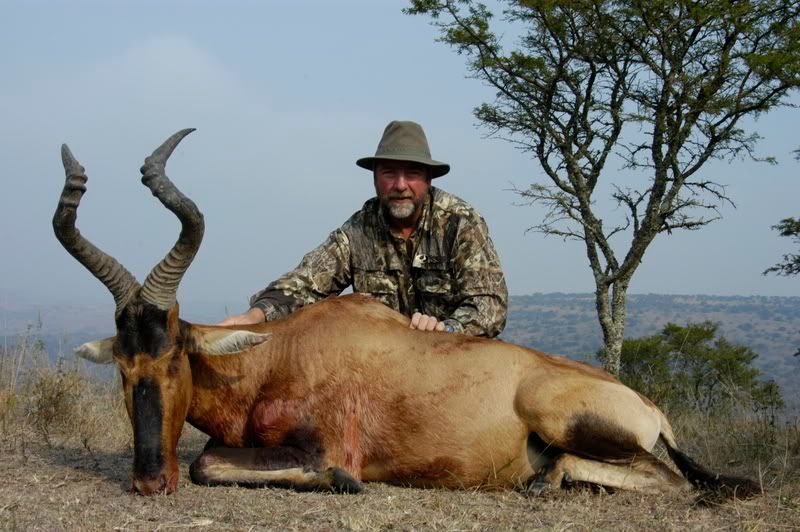 and a super Nyala 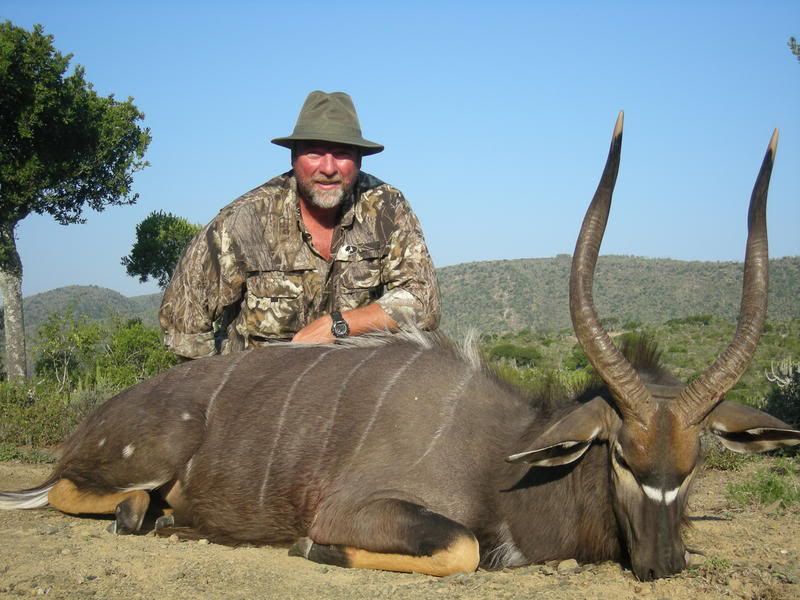 and a Black Wildebeest 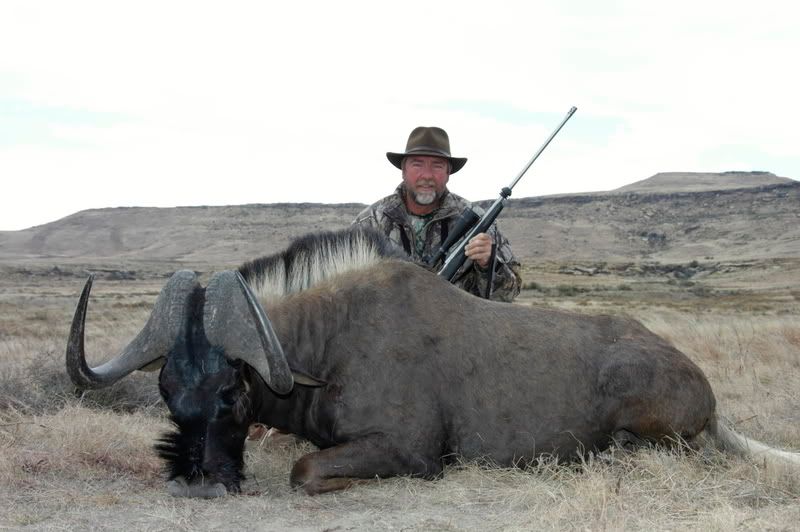 This fellow was caught stealing the beer on the previous hunt!! 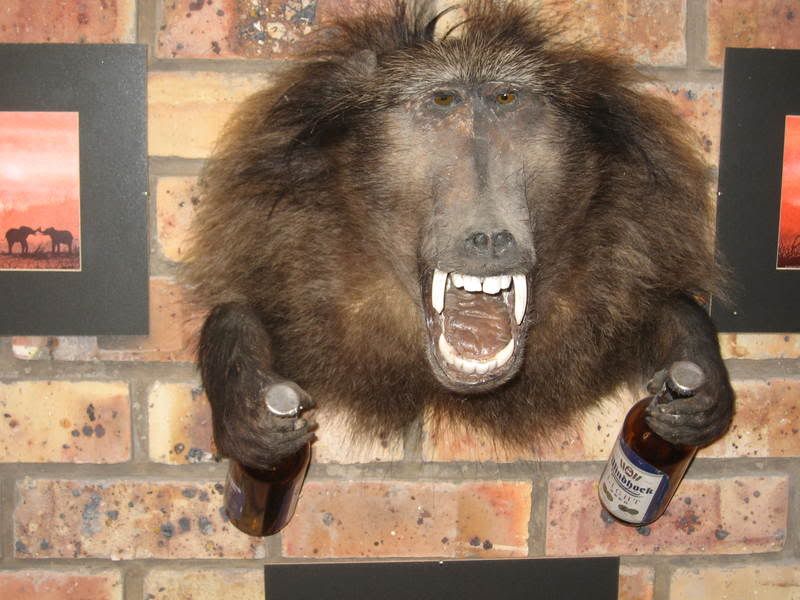 Partying till late is easy in good company and I did stay up a little later than was strictly speaking good for me and 0530hrs soon came round, in fact, too soon came round and a somewhat jaded Scot, stumbled into the shower to wake himself up. That being effected, it was into the cammos and down to the breakfast area for coffee, before loading the kit into the truck and driving some forty-five minutes to the hunting area. PH Allan’s tracker Msetele loads up the truck 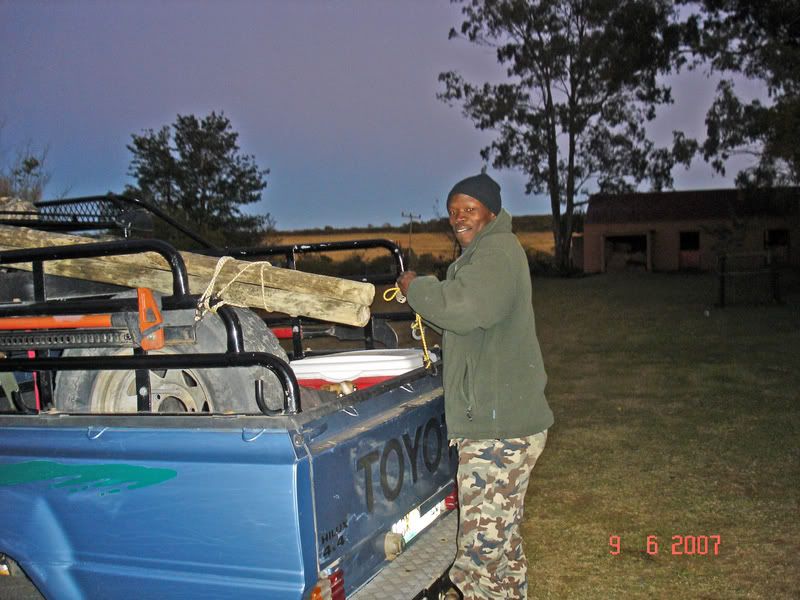 While Allan (left) and Paul have a second cup of coffee  Allan, who was the Professional Hunter who would accompany me on my hunt, has been a full time Professional Hunter for the last five years. Now, Allan may look young but do not let the boyish good looks fool you. Here is a PH in every sense of the word. A man who knows his country and the fauna thereon. Allan always seemed to know just where to point his binoculars to find the right animal and when he did, would talk his client (me) on to the selected animal just like getting a “Fire Order†in past military times. He would then brief me on how he wanted to conduct the stalk, in a polite, quiet and decisive manner, patient when I asked him to repeat any item I did not fully understand. The stalk would then be undertaken at my speed and not the speed that Allan is capable of maintaining. As an older hunter, I am no longer able to move as quietly quickly as I did twenty years before and I particularly appreciated the fact that I was never made to feel rushed or embarrassed when I would have to rest when climbing hills or negotiating a particularly difficult bit of terrain. Allan did his best to try (and most often succeeded) to get me into the shooting position with my breathing rate in a state where I had confidence in taking the shot. PH Allan, with his Ruger .300 Win Mag 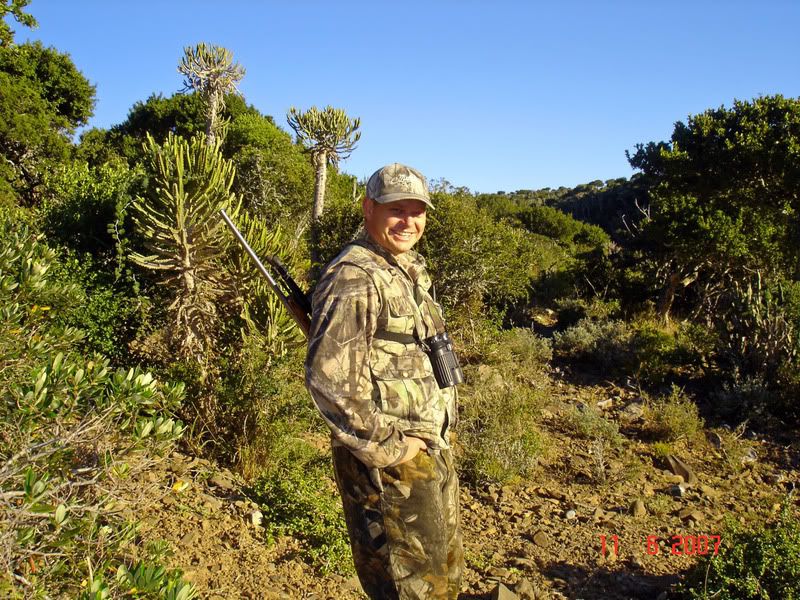 That first morning, I was to hunt for my trophy impala. I have hunted impala on other occasions, indeed my first hunted animal in Africa, some ten years before, was an impala but this was to be my first trophy impala and was intended to join that first impala on my trophy wall. Arriving at the hunting ground, we met the farm manager, who gave us some information as to where he thought the animals might be and having parked up the truck, I loaded up my rifle and followed Allan into the bush. The first animals we saw were part of a herd of blesbok, who eyed us up suspiciously as we went by but they need have had no fear on that morning. We had walked for about two hours without seeing any impala, when Allan suddenly motioned me to stop. He pointed up ahead and about seventy yards in front, I saw a young blesbok. As a practice exercise, we stalked up on that blesbok. At fifteen yards, Allan passed me his video camera and he moved forward in an attempt to get close enough to touch the blesbok. In the event, he did get to about ten feet from the animal before it realised he was there. Allan’s parting comment was, “Wish I’d have had my bowâ€. Having had no luck in finding an impala, Allan was thinking as to where our next direction should be when his thoughts were interrupted by his cell phone. (No, he didn’t have the ring tone audible, just on vibrate.) It was Andrew, the boss. He and Paul had been out looking for a baboon (Paul likes to shoot baboons) and having located a baboon and taken a successful shot at just a tad under eight hundred yards, was driving along a mountainside track, when he saw a fine kudu bull down in the valley, a goodly distance away. Paul volunteered to give up his afternoon hunt to stay and watch this fine kudu and to follow it until Allan and I could get back to Andrew’s land and stalk this kudu bull. By the time we had called in to speak with the farm manager and to advise him that we had been unsuccessful in our impala hunt, it took us around one and a half hours to get back to Andrews land. We parked up the truck at the high end of this steep sided and deep valley and proceeded on foot. I do not have a picture of this terrain as negotiating it took all my concentration and my camera was the last of my thoughts at the time. Suffice it to say that the valley side would have been forty-five degrees and just barely negotiable for me. Difficulty was compounded by a mass of thorn bushes and loose rocks. I could hear Allan communicating with Andrew about the kudu’s whereabouts but the kudu could not be seen from our position. We moved some fifty to seventy-five yards down the valley side and then stalked along, parallel to the valley floor, about two hundred yards away. The stalk was very hard for me and at one point I lost my footing and went down on my butt, barking my right shin on a sharp rock. However, the rifle and scope were saved from hitting anything unfriendly and me being full of adrenalin, did not feel any pain till later. So recovering and having assured Allan that I was O.K., we made our way further along and downwards into the widening valley. After what seemed like an age and not the forty-five minutes that it was, we stopped at a fairly sturdy thorn tree with a wide fork that would give me a good shooting rest. The subject kudu was feeding behind a group of scrub, aloe and thorn trees but was not visible to us though Paul and Andrew kept assuring us that the bull was still there, standing in some dead ground behind the cover. I settled in to a comfortable shooting position, or at least as comfortable as a forty-five degree, loose rock slope will allow and scanned the target area through my binoculars. The range finder told us that the distance was two hundred and eighty five yards and Allan asked if I was comfortable with that range. (Kei River PHs will never push a client into taking any shot, at any distance, if the client is not fully satisfied that the shot is right for him or her.) Answering that the shot was fine, I waited, uncomfortably in the shoot position for about fifteen minutes but the kudu must have been enjoying the eating where he was, as he never moved out of the cover. The consensus was that if startled, the kudu would run out of the blind area and down into the valley, obliquely and across to our right. There he should pause for a second or two, looking back towards the cause of his alarm. It was then that my .300WSM would claim its first kudu. Consensus again decided, that Paul should fire a shot towards the kudu, to spook him out for me and having clocked that the kudu was out of range for his rangefinder, (800yds which later turned out to be 1200yds), fired towards the kudu. He could see that his shot had dropped well before reaching the kudu but had thought that the noise from his 7mm Remington Magnum would encourage the kudu to take off. Wrong! The kudu acted as if deaf and did not even look up. Paul fired again with a similar result and then again but the kudu just kept on feeding (We could still not see even a horn tip of this kudu bull from our position.). Paul’s Night Force scope with its Kenton Industries Turrets is graduated up to one thousand yards, so Paul wound up the elevation, took aim at the kudu and fired. Still no reaction. The kudu kept on feeding. We then asked Paul to apply a bit of extra elevation and try to put the bullet as near to the kudu’s feet as possible. Paul replied that he was worried that he might hit the kudu but was persuaded that he would not. So, Paul applied a bit of hold over and fired, only to see the kudu collapse in a heap, as if struck by lightning. Of course it had not been struck by lightning but by a 140gn Nosler Partition, which must have come down on the kudu like a mortar round!! Same result, stone dead. It is hard enough to drop a kudu at normal ranges with one shot and I do not think that there have been many taken at what turned out to be twelve hundred yards. One usually hears stories like this in a bar, with the teller filled with bonhomie and alcohol but I assure you it is true. As you can see, the kudu was in a difficult place to access judging by the perspiration on Paul’s face, it got to Paul’s son Tom as well. 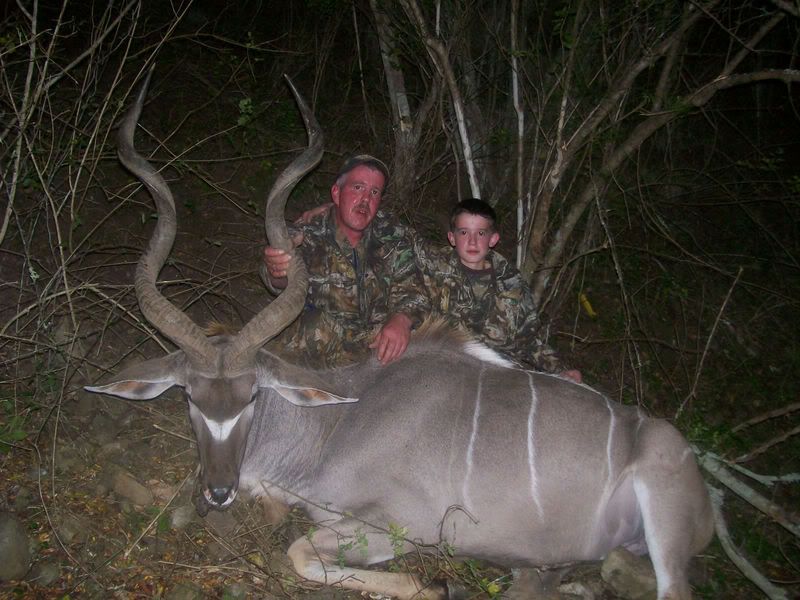 Andrew’s young son Cameron was there too but that was the next morning. 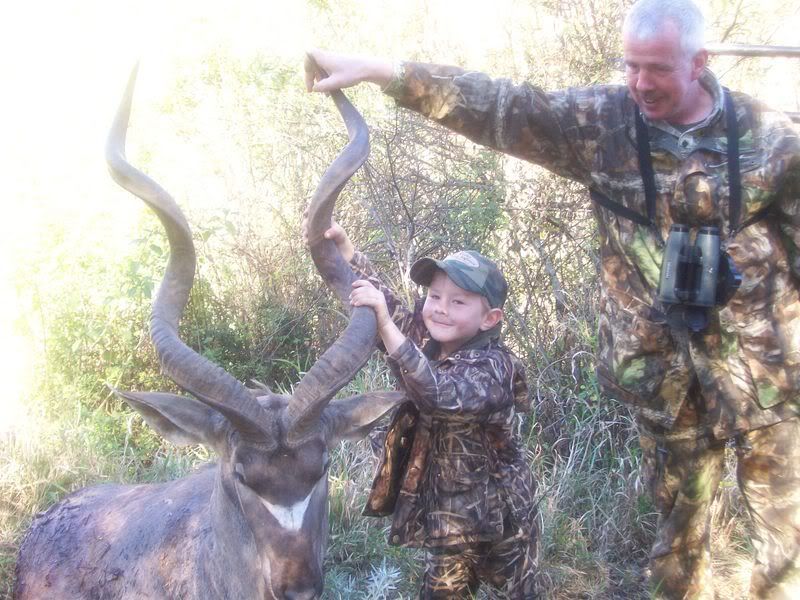 Of course Paul was embarrassed as he had just done what he told us he did not want to do and we had encouraged him as we did not believe that it could be done!! All I was thinking was that where I had struggled to get down to my shooting position, I must now struggle to get back up to the truck. I proceeded to do so and started my one hour trek back to the truck, crying over a lost kudu and consoling myself with the thought that Paul and Andrew would have to retrieve the shot kudu (In the event, the kudu had to be quartered and carried out.). By the time we got back to the camp, restored ourselves to our personal comforts and met up in the bar, there had been much Mickey taking about kudu poaching and magic bullets etc. A few beers and a good laugh later, we were to be found at the dinner table, enjoying a fine dinner accompanied by copious quantities of good South African wine. Coffee and brandy at the bar preceded a much needed good night’s sleep. No kudu and no impala but a hunting story never heard before (Or do you know different??). Iain had likewise had an unproductive day. He had been hunting a caracal (lynx) with dogs but had no more success than I. Each evening, it is the norm to discuss and plan the next day’s hunt. As far as is possible, the order of the hunt species is as the client wishes. Obviously it is not always possible to have it just the way one would like (logistics can interfere) but if the client’s order of hunt can be met, it is. For my part, I had no preference in the order that I hunted my package and advised Allan and Andrew that I would leave that detail to them. One of the Kei River Hunting Safaris concessions is a place called Huntshoek. This is a very large game farm some two hours drive from Rentons’ Lodge (The Kei River Hunting Safaris main base.) At Huntshoek, I could hunt for kudu, nyala, impala and warthog, so it was decided that Allan and I would travel to Huntshoek and stay there for two or three days as may be necessary. Huntshoek is managed by a most genial, friendly and hospitable gentleman called Charles. I had met Charles the previous year and enjoyed some coffee and conversation with him. Charles has a lovely hunting lodge on the farm, set in a commanding position with stunning views of the landscape. The lodge has a large observation deck area and I was looking forward to sitting there after the hunt, beer in hand, going over the days hunting. Regrettably, this was not to be, for it turned out that the lodge was being fully renovated and accommodation was not available. Charles did offer to accommodate us in his personal bungalow but we felt that such an imposition would be unfair and we (politely I hope) declined Charles’ kind offer. Since it was a two hour drive to Huntshoek, it was reveille at 0430hrs and off while still dark at 0530hrs. We arrived at Huntshoek at around 0730hrs and immediately called on Charles, who, hospitable as ever, offered us coffee. Being keen to make use of the early morning we declined. Charles offered us the assistance of one of his trackers, a man by the name of Rube, who was intimately knowledgeable of the land and of Huntshoek in particular. This assistance we accepted with alacrity and it was into the truck and off. Nyala was the first species on the list and I was fairly excited about it. Nyala are beautiful creatures, a bit like the Bush Buck’s big brother and those of you who have read of my previous hunts, will remember how much I like these tenacious and aggressive little antelope. The thought of a full shoulder mount Nyala on my wall had been in my mind for the previous nine months or so and now it was time to make reality of the dream. We drove out to a likely area and then proceeded on foot, along and down the side of a steep valley, the sides of which were thick with trees and bushes, euphorbia, aloe and acacia, to name but some. Stopping frequently to thoroughly spy the opposite side of the valley with our binoculars, we picked out some kudu cows and a couple of young bulls. Kudu was on the list of course but neither of the two bulls was of trophy class, so we stalked on. After some thirty or so minutes, Allan froze and motioned me to be still. He had picked out some nyala cows and where there were cows, bulls would be present. After some careful glassing, we picked out several young bulls and many cows and Allan studied each bull to assess the trophy quality. After some minutes, he said, “There, that’s the one.†He directed me on to what was a lovely big nyala bull, with good big horns which had white ivory coloured tips. A perfect trophy. Very carefully, we stalked further down the valley side until we were just a little higher up than the target bull on the opposite side of the valley. We had plenty of cover and as long as the wind did not betray our presence or we did not make a noise, we should not disturb the nyala. I settled into a shooting position and picked up the nyala in my sight. Allan advised the range at a hundred and fifty-eight yards. It seemed to be a long time I watched that nyala, waiting for him to move through the scrub and trees to a position where I could get a clear shot. My rifle was sighted in at two hundred yards so it would be a point of aim shot and I could see the mount on my trophy wall already. Eventually, I had a clear view of his top half and fired to hit him high on the shoulder, where the neck becomes spine. The thump of the 180gn Hornady SST was very audible and the nyala bull was knocked off its feet on to its back, where it lay, kicking its legs and braying. I had thought it dead but after a few seconds and to our surprise, it got up and moved off up the valley side and to my right, where I lost view of it. It seemed to me that there were nyala running everywhere and finding the one that I had bowled over was not easy for me but Allan had never taken his binoculars off it and could tell me where it was. However, one acacia looks like another and I could not pick the nyala up in my sight. I offered my rifle to Allan, to take a second shot but before he took the shot, the nyala came clear of the bush and Allan handed the rifle back to me. By the time I picked the nyala up in my sight again, he was half in cover. However, he quickly moved out to where I could get a similar shot as before and I fired, hitting him again and hearing the thump of the bullet as it struck him. Again and to my surprise, the nyala did not fall but moved up over the valley rim and disappeared. Knowing that the bull was well hit and that we had two trackers and Allan’s two Jack Russell dogs, Fletch and Masie, I did not feel we would have much of a problem in finding the shot animal. Unbeknown to me, Allan’s tracker, Msetele, had captured the shots on video so we were able to watch the scene and assess the state of the shot animal. The video clearly showed the two bullet strikes, both higher than intended and almost in the same place. We were of the opinion that the animal would be found dead, just over the other side of the valley. (If anyone would like to see the video of the nyala shot and some others that were captured on video, send me an E-mail and I will send it to you.) Moving across the valley, we looked for blood and did find some but not a lot. We quartered the ground in extending pattern for some three hours before stopping for some water and food. Allan transferred the video from his camera to his laptop to give us a bigger picture but our conclusions were as before, the animal should be on the ground. We drove back to the main buildings and showed the video to Charles, whose immediate reaction was, “That animal is dead.†Charles gave us three more of his farm workers and we went back to try to find it but although we searched till almost dark and covered a very large area including the valley where the nyala was shot and the two further valleys and the river area that the valleys ran down to meet, we could not locate the unfortunate nyala. We had to call the search off until we could resume the following morning but before leaving Huntshoek, I asked Allan to set me up a target at two hundred yards. Having done so, I sat with my back against the truck and put two rounds right where they were supposed to go. Nothing wrong with the rifle. That night, Charles had booked us in to a small hotel. Comfortable and adequate, run by a man and wife team, we were fed and watered well but somehow the Windhoek beer did not taste as good as it did the night before. The thought of the wounded nyala dulled the flavour for me. First light saw us out looking again, seven of us and eight when we were later joined by Charles. That day was the most exhausting day of my hunt. We were up hills, down dales, along rivers, through bushes, up valleys, through brush and bushes and though we did find a dead warthog, we could not find the dead nyala. At around 1400hrs, Allan and I broke off the search to continue the hunt, leaving Charles’ farm hands still searching for the nyala. Looking for the nyala 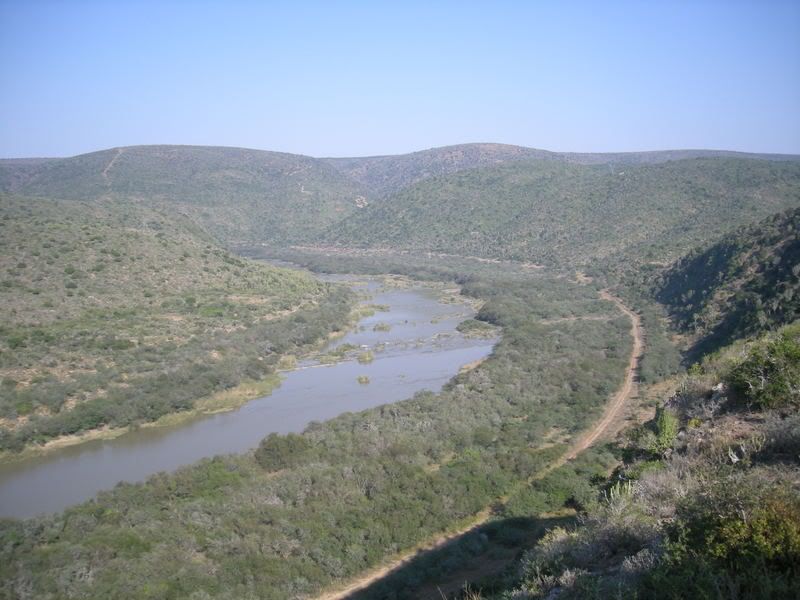 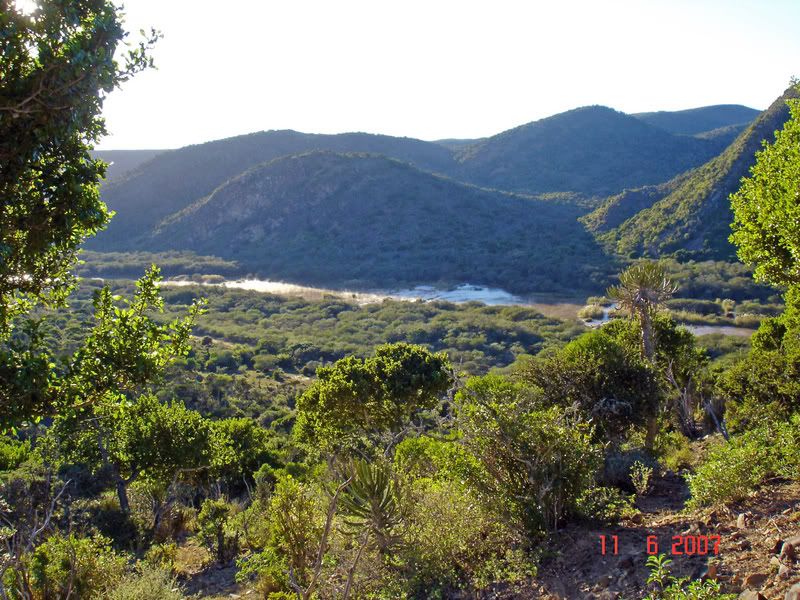  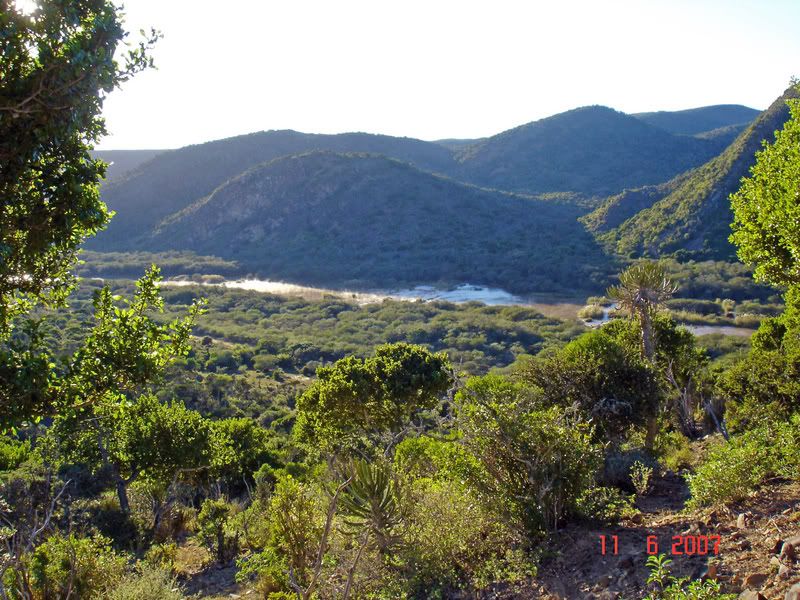 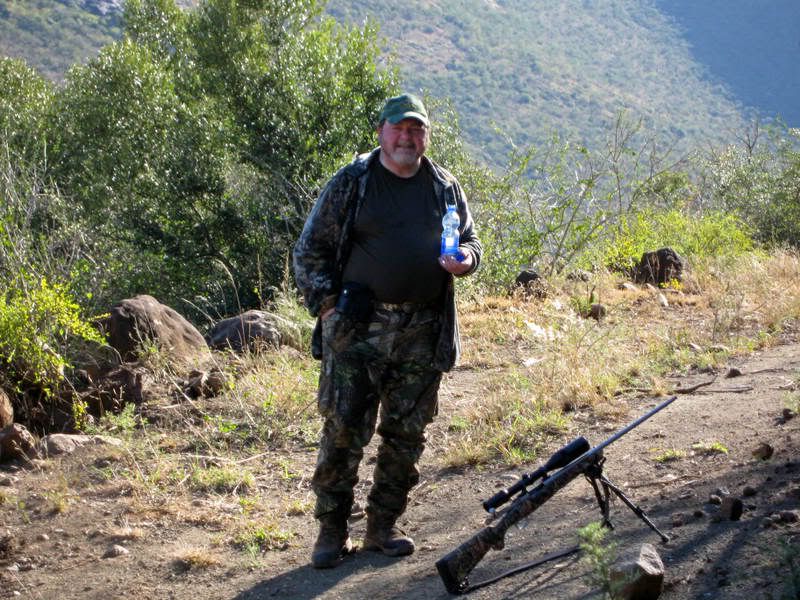 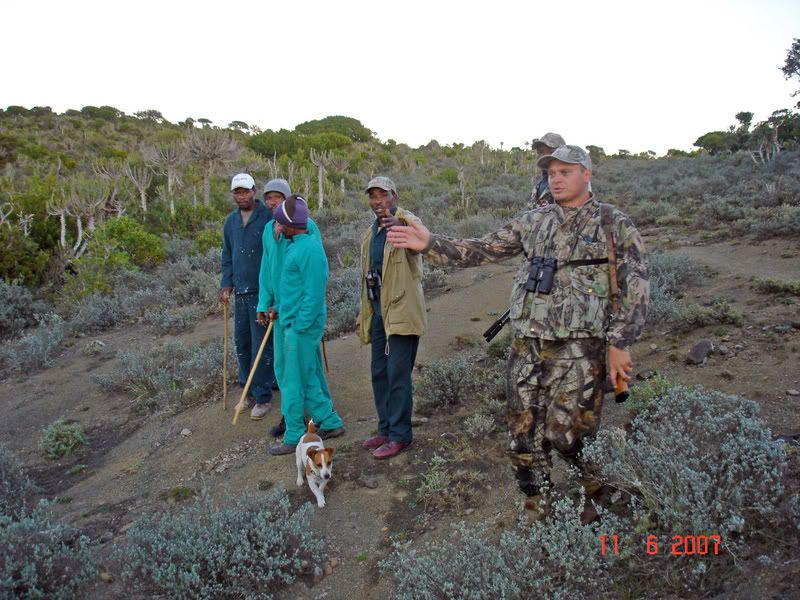 After a sandwich and some water, we took off for an area situated reasonably near to a water hole and it was not long before we spied a herd of impala some distance away. We stalked out towards them, stopping frequently to watch them through binoculars, trying to ascertain if there was a suitable ram amongst the group. There was, a fine light coloured ram with wide straight horns. All we had to do now was to stalk within range and all that the ram had to do was present himself for the shot. We stalked in to two hundred yards from the ram and Allan set up the shooting sticks. I placed the sight on the ram and waited for him to give me a clear view. He was quite easy to follow as his lighter colouring made him stand out from the rest of the herd. The herd was feeding in some fairly high scrub so it was some time before he walked out into a small clearing but he did not stop and carried on to stop behind another clump of shrub. Suddenly, he turned around and walked back into the clearing, pausing for a moment. That moment was enough, my bullet struck him in the spine and he went down like a sack of potatoes. Impalas were running in all directions but I was sure that my ram was on the ground. Walking slowly to the spot where he had been standing, we found that to be the case. There he was, a fine impala ram. Here he is, along with the rifle that had brought about his demise. 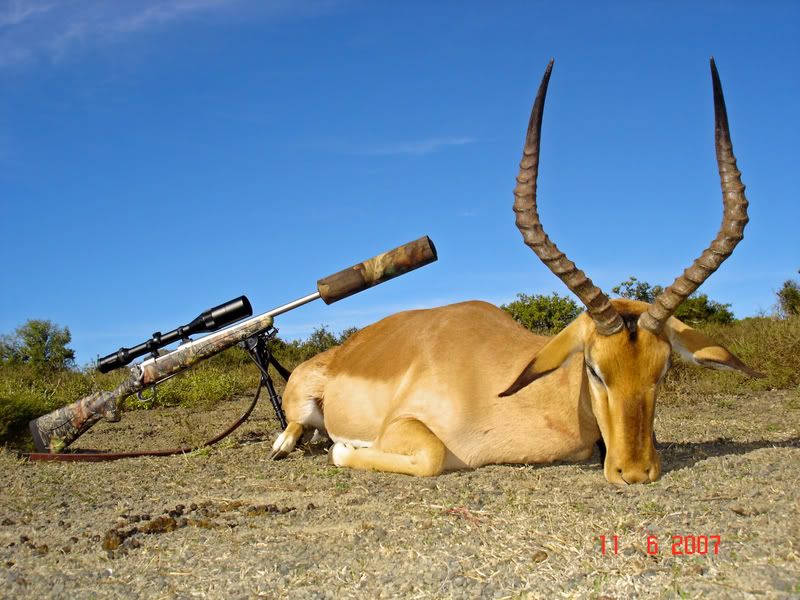 A happy Roebuck. 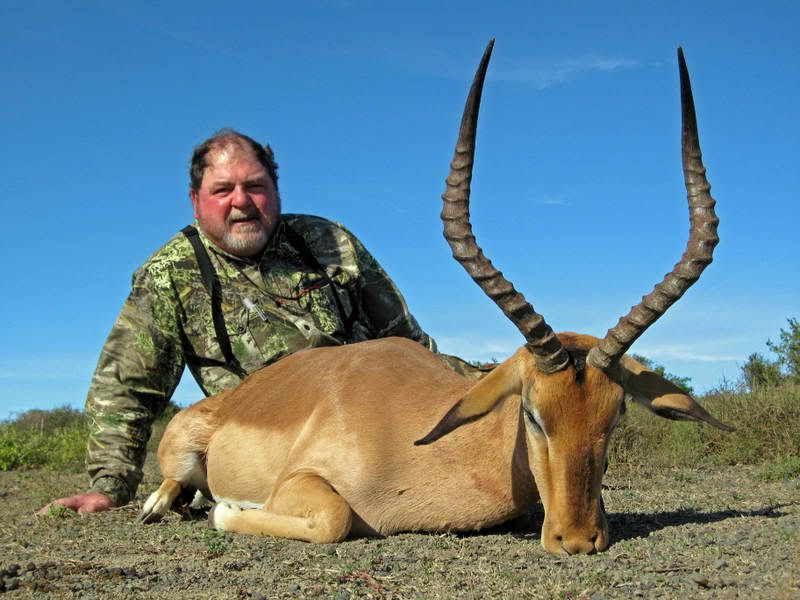 With trackers Rube, Msetele and PH Allan. 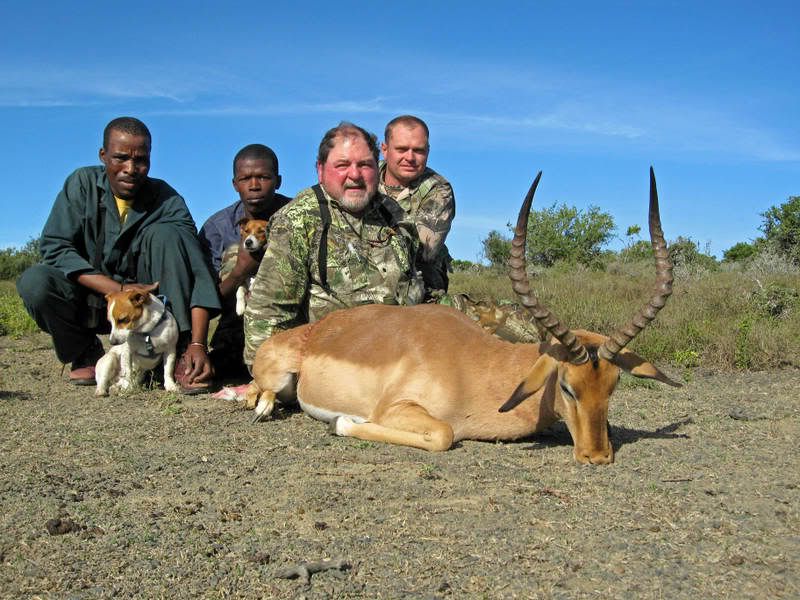 Msetele hoisted the impala on his shoulders and carried it the truck. Just the job for a fit young man but even he looked as if he had stepped from a sauna when he reached the truck! 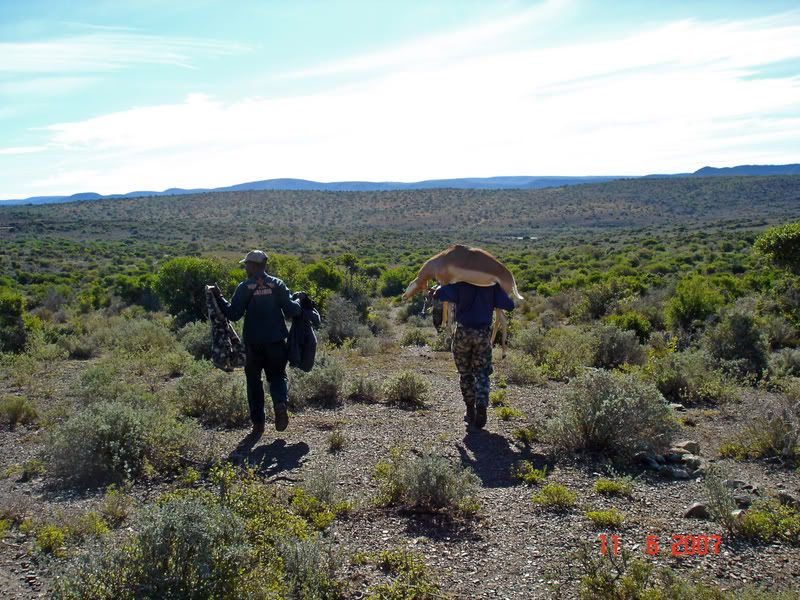 We still had some light left so Allan suggested that we might go and look for some last light kudu. The kudu, I guess, is everyone’s favourite. It is a strikingly beautiful antelope, with highly developed sense of smell, hearing and vision. Their camouflage is excellent and they are not known as the “Ghost of Africa†for nothing. Literally, they are there in plain view one minute and invisible the next. We searched for a long while but although we did see kudu, there were none of trophy standard. There was one thing that I did pick up on. The minute Allan announced that we were going after a kudu he changed visibly. He became much more intense and concentrated, focussing on little things ignored before. When I asked him if he was aware of this, he replied that “Kudu are different†and that most PHs love the challenge of a kudu hunt. I wonder what he would be like on a lion hunt!! Earlier that day, we had stumbled on a caracal (Lynx), whilst looking for the nyala and when light had faded and we were returning to the base, I saw another. One is allowed to shoot caracals free of charge, like baboons, when you happen upon them opportunistically but in this case, they did not give me the chance and both cats got away safely. Perhaps next time? We made our weary way back to our hotel, stopping by the base buildings to see if there was any news regarding our nyala but alas, there was none. The farm hands said that they would be trying again the next day and with that sad news, we made our way back to the hotel where after a few beers, T-bone steak and a good night’s sleep, I would be ready to try again. We were on the hunting ground before first light and made our way carefully to a likely kudu area, while the farm hands resumed their search for the nyala. Scanning all the ground carefully, Allan picked up on a good Kudu bull around kilometre away. He had good long horns with a nice twist leaving the white ivory coloured points, facing slightly forward. We started a long and convoluted stalk after this bull but it seemed to be that just as we were getting into shooting range, he would move on. We stalked that kudu bull for more than three kilometres before I finally had him in my riflescope’s cross hairs. When Allan clocked him with the rangefinder at two hundred yards, willing my breathing back to normal, I composed myself for the shot. The bull moved from cover to an area where the whole length of his back was visible. It was now or never and I squeezed the trigger and heard the reassuring thump of a bullet striking and the kudu bull staggered, moving slowly away to my left. Reloading quickly, I watched him moving slowly along and when again he gave me a similar opportunity, Allan said, “Shoot him again.†I did and the shot was a mirror image of the first shot but on his other flank. He went down to the second shot and racking the bolt again, we moved forward to where he lay. Seeing that he did not require another shot, I made my rifle safe and reached for the water whilst Allan reached for the camera. It had been a long and tiring workout for a most worthy quarry. Allan had captured the shot on video, a wonderful memory caught for eternity. Here is the kudu. 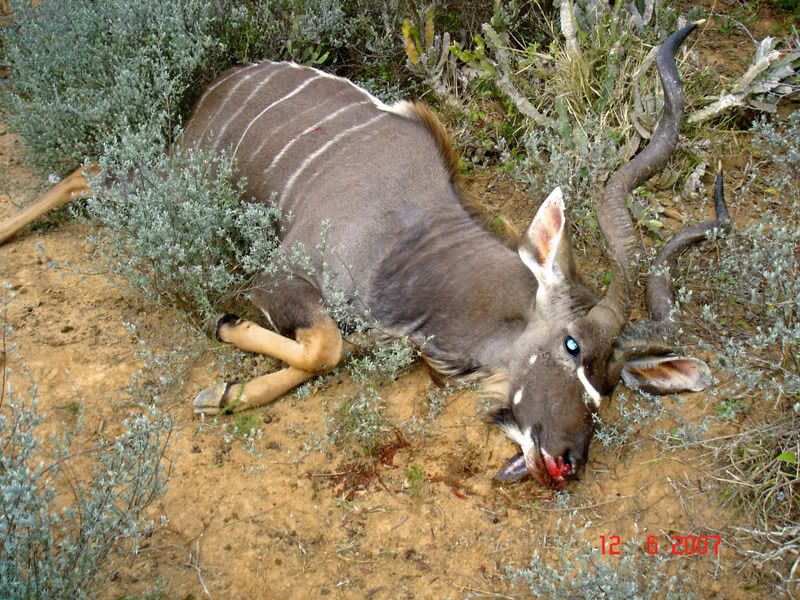 And now with a happy Roebuck. 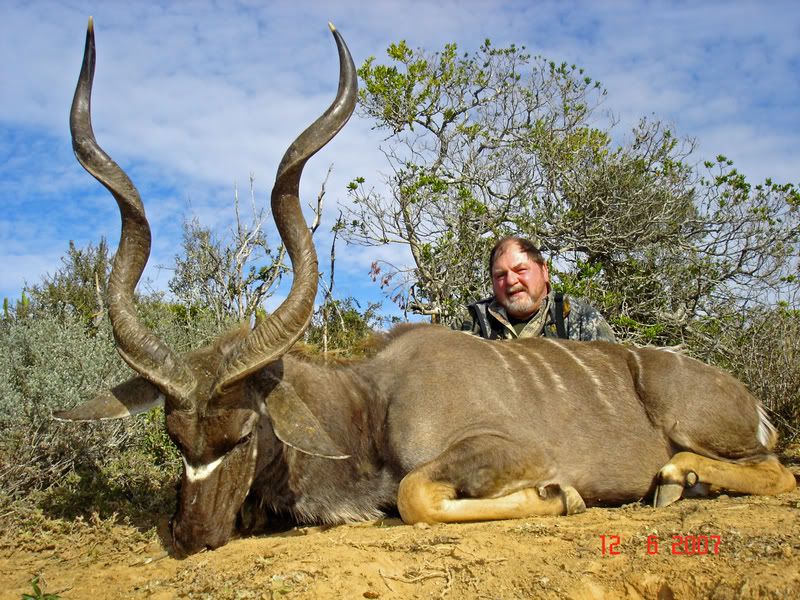 And happy Roebuck and PH Allan. 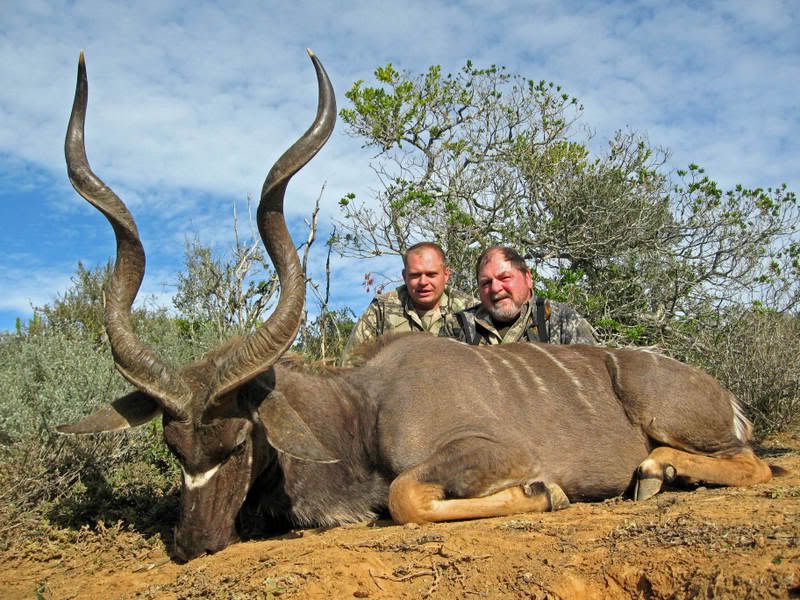 And with Rube and Msetele. 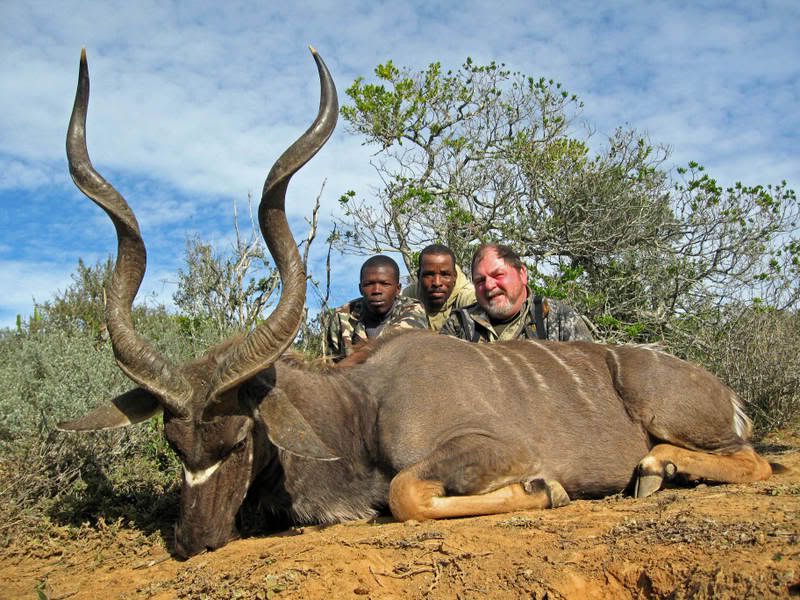 Now that we had the kudu safely taken care of and Allan had returned to his usual relaxed self, we turned our thoughts to warthogs. Now I love to hunt warthogs, I don’t know why, I just do. The humble warthog is apparently one of the top most popular trophy species. They are ugly brutes with the females only being a tad better looking than the males by having two less warts. I was looking for a better specimen than I had shot during my previous hunts and with this in mind, we set off trekking through some typical warthog country, lots of bush with plenty of thorns. Come to think of it, most bushes in Africa have thorns and one needs always be vigilant or one spends time back at camp, magnifying glass and tweezers in hand, thanking the “Powers that be†that you don’t need a mirror as well!! We came upon a group of warthog almost immediately but none were of trophy size and we carried on trekking. Suddenly Allan stopped and pointed to his left. A very nice male warthog had allowed us to creep up on him and when he realised we were there, beat a hasty retreat. Allan told me to shoot when I got the chance but unfortunately (for me not the warthog) he placed himself behind some bushes before I could get a bead on him. Allan instructed me to shoot him when he came out of the bushes and I would have done so had the warthog been listening to Allan as intently as I had. The warthog made his escape by keeping the bushes between me and him and never allowing me another sight of those lovely big tusks. No problem, we had lots of time or at least, I thought we had. Darkness comes suddenly in Africa, much more so that in Europe and when the light began to dim, we were mentally postponing the warthog hunt until the following morning. However, luck had something else in mind and as we came upon another group of warthog, Allan identified a suitable male eighty yards away. Here he is. 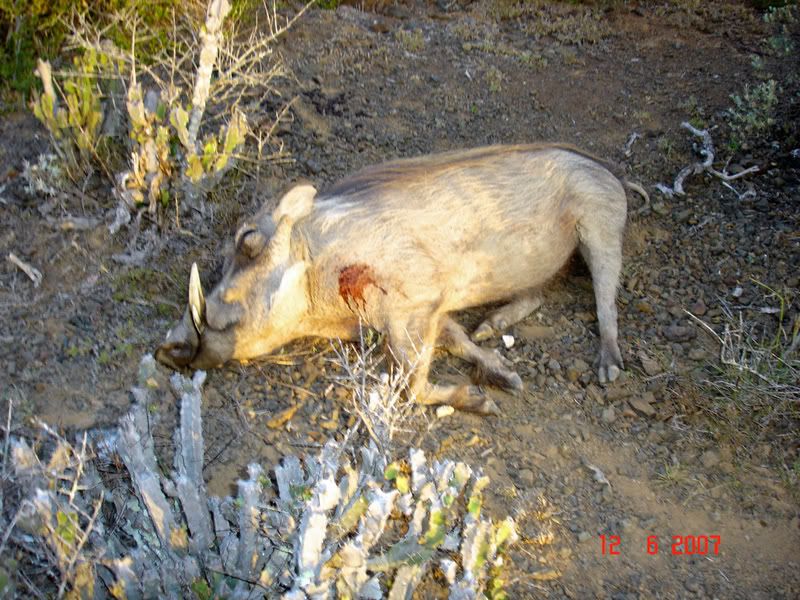 Roebuck is the one wearing the ball cap!!  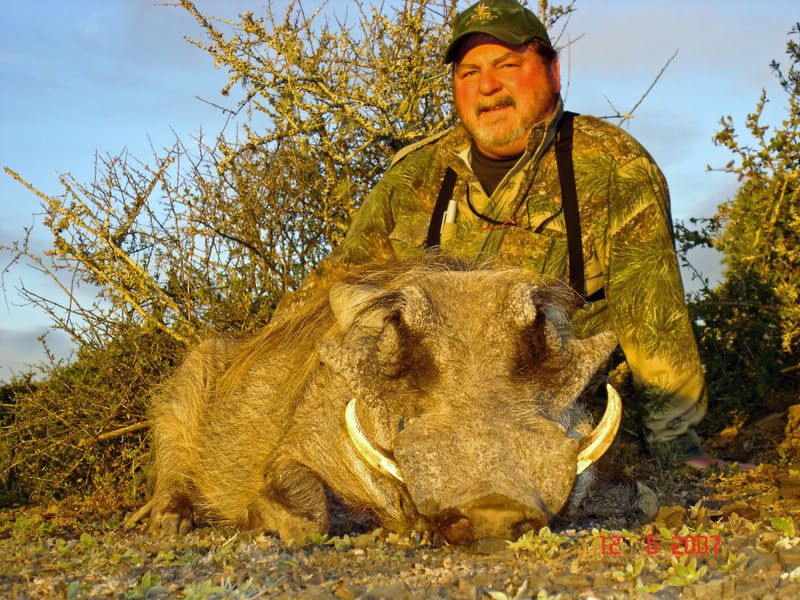 Msetele and Rube pick him up.  And carry him back to the truck.  David. www.kingstonedeer.com | ||
|
| Powered by Social Strata |
| Please Wait. Your request is being processed... |
|
 The Accurate Reloading Forums
The Accurate Reloading Forums  THE ACCURATE RELOADING.COM FORUMS
THE ACCURATE RELOADING.COM FORUMS  Hunting
Hunting  Hunting Reports - Africa
Hunting Reports - Africa  Kei River Hunting Safaris. My hunt June, 07
Kei River Hunting Safaris. My hunt June, 07

Visit our on-line store for AR Memorabilia

